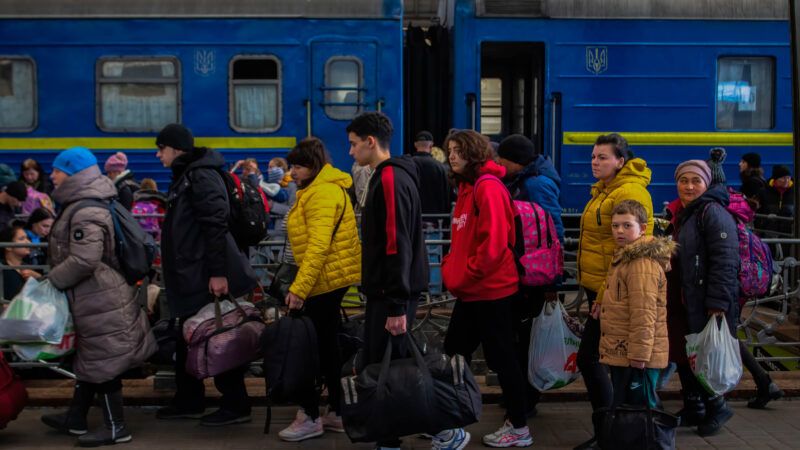The U.S. Took in 271,000 Ukrainian Refugees in a Year. It Can Handle More.
What we did for Ukrainians, we could do for other migrants too.

The Russian invasion of Ukraine last year forced over 7.5 million Ukrainians to flee their country, with another 7 million displaced inside Ukraine's borders. Many world leaders opened their doors to those refugees immediately and without much regard for routine criticisms of immigration. The same was true in the United States. When President Joe Biden announced that the U.S. would take in up to 100,000 Ukrainian refugees, there was little resistance from figures on the right who otherwise favor tighter immigration policy.
Nearly a year after Biden's announcement, the Department of Homeland Security says that over 271,000 Ukrainian refugees have been admitted to the United States. More than 117,000 came through the "Uniting for Ukraine" program, a private refugee sponsorship scheme through which Americans can volunteer to financially support Ukrainians. Another 150,000 came to the U.S. through pathways like the traditional refugee resettlement program or by crossing the U.S.-Mexico border.
Bringing in 271,000 refugees, while a modest accomplishment compared to what countries such as Poland, Germany, and Canada have done, is a huge deal in the context of American immigration politics—especially with as little controversy as it provoked. It speaks volumes about America's ability to absorb large numbers of people without changing something fundamental about its culture, which immigration restrictionists often doubt. Judging by the scores of Americans who stepped up to welcome Ukrainians, American culture is equipped to absorb.
The Ukrainian arrivals helped bolster a recovery in U.S.-bound migration. Between July 2021 and July 2022, the U.S. added over 1 million people to its population through net international migration. It marked a huge spike compared to an anemic 2020–21, which saw a net migration level of just 376,000 people. It was also the first year since 2016 in which net international migration hadn't declined. (Those numbers, which come from the Census Bureau, include humanitarian migrants like refugees and asylum seekers, as well as temporary migrants on work or student visas.)
Not all of those arrivals have received as warm a welcome as Ukrainian refugees. Many immigration hardliners opposed the relocation of Afghan migrants, with figures like then–Senate candidate J.D. Vance warning that we might get "a bunch of people who believe they should blow themselves up at a mall because somebody looked at their wife the wrong way." Since more than 76,000 heavily vetted Afghans were resettled in the U.S., a handful have been charged with crimes—but the wave of debilitating culture clash that some people predicted hasn't materialized.
Restrictionists level similar criticisms about migrants crossing the U.S.-Mexico border, using words like invasion and replacement to describe the inflows. Twenty Republican states sued the Biden administration over a recently established legal pathway that has serious potential to reduce unlawful migration by admitting 30,000 migrants from Latin American countries and Haiti per month to the United States.
In a March 2022 YouGov/The Economist poll that asked whether the U.S. should accept refugees from certain countries, 46 percent of American respondents said yes to Syrians and 40 percent said yes to Salvadorans. In another March 2022 YouGov/The Economist poll, 60 percent said that the U.S. should accept Ukrainian refugees. What explains that divide? Perceptions of cultural similarity and security may have played a role, as some researchers have suggested.
But assimilation potential is a slippery concept. Take language skills: According to EF Education First's English Proficiency Index, Ukrainians fall into the same proficiency band as Cubans, Hondurans, Salvadorans, and Guatemalans. This is roughly true of their economic circumstances as well. Ukraine's per-capita gross domestic product was $4,835 as of 2021, per the World Bank—roughly $200 lower than Guatemala and $300 higher than El Salvador.
Given those factors, Ukrainian refugees may not be as different from other migrant groups as might appear. What has been unique is the way Uniting for Ukraine has been successful in capitalizing on and building public buy-in. It offered migrants an organized, predictable, low-drama pathway, and it allowed Americans to contribute to relief efforts directly by sponsoring migrants. Ukrainians leaned into the legal immigration option, and American sponsors gladly helped them do so—both in large numbers. Contrast that with the traditional government refugee resettlement process, which resettled just 12 Ukrainian refugees in the first month following the Russian invasion of Ukraine.
The American government may not be adept at accepting and integrating immigrants, but American culture and institutions are. Over 200,000 Americans have volunteered to sponsor Ukrainians. As of November, 6,800 Venezuelans were approved to join American sponsors. Though the people who choose to sponsor refugees are likely already warm to the cause, they can help bridge the gap between those refugees and people within their communities who are less supportive. Major companies have pledged to hire tens of thousands of Afghan and Ukrainian refugees. After Florida Gov. Ron DeSantis flew dozens of Venezuelan migrants to Martha's Vineyard in a showy stunt, island locals immediately jumped to help. Nearly all of the migrants have stayed in Massachusetts.
Taking in many immigrants—from a place as similar as Ukraine or as different as Afghanistan—hasn't wreaked havoc on American culture. Rather, American citizens have proven welcoming even when politicians have stalled because that's what the culture is built to do. It's critical that the government step aside when Americans make it clear they want to help newcomers.


Show Comments (65)